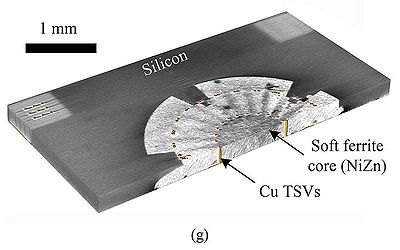LabAdviser/Technology Research/Nanofabrication of Inductive Components for Integrated Power Supply On Chip/Magnetic-core Inductor
Fabrication of powder-core toroidal inductor
Fabrication Process
A mixture of PDMS and FP350 NiZn ferrite powders are prepared and casted into a stainless-steel mold. The stainless-steel mold has two parts: a flat bottom plate and a top plate with a 6 x 6 mm, 300-µm-deep cavity. Two parts are attached together to create the mold in which the FP350-PDMS composite is printed (step 2, Fig. 2b). A planarization step is done to get the desired composite thickness of 300µm (step 3, Fig. 2c). An air-core toroidal inductor is immerged slowly into the mold until the top windings are covered. The sample is cured at 75 oC for 3 hours on a hot plate. The magnetic-core inductor is obtained after releasing from the mold (step 6, Fig. 2f). Fig. 2g shows a cross-sectional micrograph of the fabricated TSV magnetic-core inductors scanned by an X-ray inspection system XD7600NT (Nordson DAGE Corp., UK). It is clearly shown that the magnetic core is fully filled without air-voids. In addition, it is noticed that the magnetic material covers the top and bottom windings thus confining the out-of-plan one-turn flux to further minimize the EMI issue.
A manual casting process for magnetic core fabrication. (a) Step 1: a stainless-steel mold with a 0.3-mm-deep, 6 x 6 mm cavity, (b) Step 2: casting of the composite material into the mold, (c) Step 3: a planarization step is done to get a uniform composite layer with a thickness of 0.3 mm, which is designed to be slightly thicker than the inductor thickness of 280 µm to avoid overfilling of the core material over the copper windings. (d) Step 4: immerging of the air-core inductor into the composite layer, (e) Step 5: the core is cured at 75 oC for 3 hours, (f) Step 6: the inductor is released from the mold. (g) A cross-sectional micrograph of a fabricated TSV magnetic-core toroidal inductor scanned by an X-ray inspection system XD7600NT (Nordson DAGE Corp., UK).
The important parameters in the casting process are (i) a high-concentration core for a high inductance density, (ii) a homogeneous core with uniformly distributed magnetic powders for a good isolation between the powders, and (iii) a void-free filling without air gaps. In case of distributed air gaps, these will reduce the effective core volume thus reducing the effective permeability (µeff). In addition, they can create thermal instability due to the thermal expansion generated by the cycled temperature during operation. The casting process is optimized towards these objectives by varying the powder content (CFP350). A high CFP350 increases the possibility of forming air gaps. Six inductors were fabricated with the CFP350 varies from 63 to 88 weight percent (wt%). The results are described in Fig. 2. At CFP350 = 88 wt%, big air avoids were observed as shown in Fig. 2b. The maximum CFP350 is 84 wt% for a void-free core as shown in Fig. 2c. Other factors are the curing temperature and curing pressure. A curing temperature was optimized at 75 oC.
X-ray micrographs of the fabricated TSV inductors. (a) A 25-turn, 350-m-thick TSV air-core toroidal inductor. TSV magnetic-core inductors with the conventional-core content CC = 88 wt% (b) and 84 wt% (c). The micrographs were captured by an X-ray inspection system XD7600NT.
A cross-sectional x-ray micrograph of void-free magnetic-core toroidal inductor. The micrographs were captured by an X-ray inspection system XD7600NT (Nordson DAGE Corp., UK).
A 3D X-ray micrograph of the fabricated TSV magnetic core inductors. Silicon is set to be transparent. The micrographs were captured by an X-ray inspection system XD7600NT.





